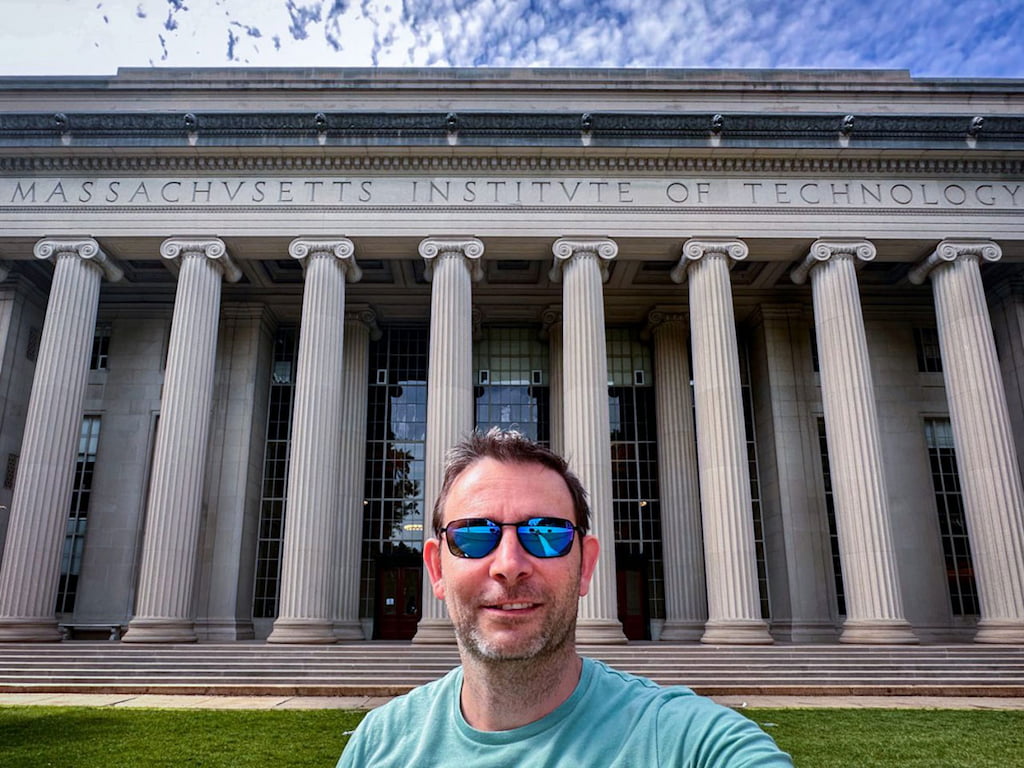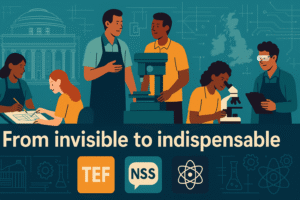Dr Tim Savage, Director of Technical Learning at the University for the Creative Arts was one of the first to go on a UK ITSS funded Knowledge Exchange Placement. We caught up with him to discuss his experiences at Rhode Island School of Design (RISD) and Massachusetts Institute of Technology (MIT) and the impact it’s had.
When I joined the higher education sector in 2000, I was struck by how technical and academic teaching practices were regarded so differently yet shared many similarities. Things have moved on a little in the last 25 years, but these early career experiences have stayed with me, influencing my research and learning interests.
The ITSS Knowledge Exchange Placement programme allowed me to visit two of the top five world-leading universities for the creative arts (MIT and RISD) in the USA. This immersive experience enabled me to explore US models of technical leadership, management, the relationships between academic and technical staff in real-world settings.
By working with technical managers, I was able to understand better how teaching technicians operate in the US educational system. Being embedded in their daily culture and engaging directly with technical staff, academics, and senior leaders allowed me to both share best practices from my own institution and learn from theirs.
Specialised equipment
MIT has incredible resources, particularly in digital technologies, engineering, and fabrication. The configuration, operations and functions appeared to be grounded in investigation, experimentation, and innovation. I was reminded of Bauhaus’ concept of ‘studios and workshops’ as ‘laboratories of art’, where the boundaries between arts, sciences, and psychology blur to establish new connections and deepen understanding.
An area where this was particularly prominent was the Edgerton Centre, named after the technician and photographer Harold Edgerton, whose innovation in designing the electronic camera shutter led to the iconic milk drop coronet image. The brand of creativity I observed at MIT was instrumentalised in support of innovation and problem-solving, as opposed to the conceptual and cerebral creativity more commonly associated with the fine arts.
At the time of my visit, I had been working to procure motion capture and photogrammetry resources at UCA, and I was fascinated to observe how technicians were developing these same facilities with the capacity to operate at sensitivities beyond the human senses. Whereas ‘technical’ can sometimes be perceived as secondary and supplementary to knowledge creation in the arts, at MIT, the development of technique and informed evolution of instruments extended the scope and scale of ambition, diversification of research and new possibilities.
RISD shared many similarities with MIT. I was able to view world-famous furniture design workshops and observe how traditional craft and analogue processes, skills, and techniques were being integrated with new and emerging technologies.
The ambisonics sound studio for research in sound technology also serendipitously aligned with the research specialism of a colleague at UCA. I was able to share contacts and information. I was also interested to see how RISD staff had collaborated with NASA to design and produce gloves for astronauts using advanced fashion technologies.
Impact and insights
I observed plenty of similarities with technical roles in the UK but also striking and intriguing differences. The spaces, equipment, and curricula were broadly similar to those I am familiar with, and the interactions I witnessed between technicians and their learners resembled those of my home institution, and pedagogies were consistent with my UK-based research.
At a cultural level, the few peer-reviewed studies that have been published in the UK about technicians, and the groundbreaking UKRI funded TALENT Commission, consistently describe technicians being ‘invisible’, or considered ‘second class’.
The same phenomenon was evident in the US. Moreover, I observed an even more pronounced distinction and division between ‘them (academic staff) and us’ (technicians).
This was highlighted during an awards event at MIT when the Head of Architecture took to the stage and described the established and accepted hierarchy of the institution as being 1. Faculty (academic staff), 2. Students, 3. Furniture, and 4. Administration (non-academic staff).
However, this apparently derogative statement was tongue in cheek as the comment was made while presenting a technical instructor (Gearóid Dolan) with an award for high performance.
The theme of technicians being undervalued was repeatedly echoed by the technicians that I spoke to during my visit. Several described a disconnect between faculty and administration that – they believed – created an imbalanced and disjointed delivery model, that inhibited constructive alignment of the curriculum and impacted upon the student education and experience. One technician described, ‘anyone can draw an elephant that flies, it’s quite another to build one.’
My contacts in the US were especially keen to learn more about the work of the Technician Commitment and UK ITSS. I was fortunate enough to spend time with the Touba Ghadessi (Provost at RISD), talk her through the TALENT Commission and advocate for the recommendations and benefits of recognising and integrating technical teaching with academic delivery.
Cultural differences
The variances between the cultures were also quite striking, and the roles and responsibilities of technicians were influenced by national and institutional contexts. For example, while there local ‘codes’ of safety surrounding common hazards (electrical, chemical, fire, etc.) exist, there is no overarching legislation, or the equivalent of the Health and Safety at Work Act 1974. Consequently, institutions had greater latitude in their interpretation of safe working, which appeared to vary significantly.
Something that struck me was the increased level of trust institutions placed in their students, particularly at MIT. When speaking to the Estates team at MIT they mentioned that a student had asked for three phase power to be added to their halls so that that they could use power tools in their room, and this has been approved and actioned.
The project in question had been to enable the manufacture of a working timber roller coaster out of hours, complete with loop-the-loop, that visitors to the end of year show would pay to use, and the funds used to offset show costs. The students were encouraged to learn the technical requirements and material properties, and presented their calculations to the technicians, who had little involvement with the actual build.
In addition to variation within health and safety legislation, the US sector appeared unconcerned with many of the metrics contribute to directing technician activity in the UK. For example, there is no National Student Survey (NSS), or Teaching Excellence Framework (TEF), or Graduate Outcomes Survey (GOS). Quality assurance and enhancements were managed locally within institutions and did not include technical staff. There was no incentive for technical staff to gain teaching qualifications, and no equivalent to Advance HE Fellowships. While there was no equivalent to the Technician Commitment, there was a much stronger union presence that dominated many of the conversations I had with technicians.
Conclusion
I was incredibly impressed with the technical resources and staff at these prestigious institutions and given the similarity in equipment, materials, techniques and processes generally unsurprised to see many of the long-standing challenges technicians face in HE replicated in the US.
While I learned a lot about the similarities and explored the differences in culture and organisation, I was encouraged to observe the appetite and enthusiasm that US technicians expressed for the UK initiatives, research and knowledge.
Since returning to the UK I received enquiries from technicians at other US institutions expressing their interest. Of course, there is still plenty of work to do, but comparatively, my sense is that the UK is leading the way in this critically important space.
The insight gained on the placement also proved invaluable to contextualising research for my PhD Teaching to the line: how do visual arts technicians in higher education conceive of their pedagogies.
It also informed my article co-written with Kelly Vere about technicians working in the third space Why is it problematic for technicians to say they teach in higher education? article in the Journal of Learning Development in Higher Education.
I should also note that this blog article is based upon my observations and selective anecdotes from two different and distinct institutions and should not be read as an objective comparison of UK and US educational models.
Finally, I would like to express my deep gratitude to the ITSS for funding this placement, UCA for supporting me, and my contacts at MIT (Hayami Arakawa) and RISD (Dylan Costa) for their kind and generous hosting.
This blog article is based upon observations and selective anecdotes from two different and distinct institutions and should not be read as an objective comparison of UK and US educational models.

